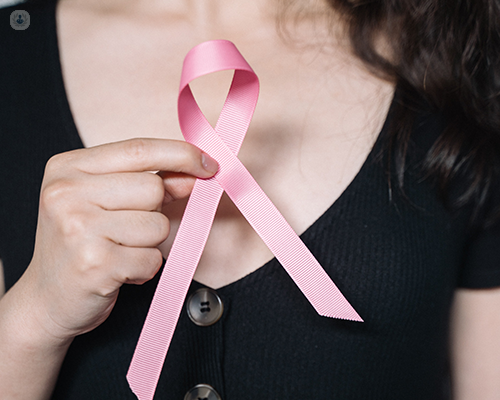Reconstructive surgery after breast cancer
Written by:Breast reconstruction commonly refers to reconstructing a new breast shape or mound using surgical techniques. It is commonly performed after a mastectomy, which is the removal of the whole breast or part of the breast, which is referred to as breast-conserving surgery.
Reconstruction can be done at the same time (immediate) or sometime down the line (delayed), and this is decided by the surgeon and patient, depending on a whole host of factors, such as type of cancer and planned treatment.
Mr Hussein Tuffaha is an Oncoplastic and Cosmetic Breast Surgeon who will explain all about the procedure and what to expect.

Who can have breast reconstruction surgery?
Breast reconstruction is a good option if you are coping well with your breast cancer diagnosis and treatment. It is suitable for a woman who does not have additional medical conditions or other illnesses that will hinder healing. Also, it really helps if the woman has a positive attitude and realistic goals for restoring their breast and body image.
What are the options for breast reconstruction?
During reconstruction, we can create a breast shape using an artificial implant (implant reconstruction), or by using a flap of tissue from another place on your body, such as from muscle tissue and fat from your back, buttocks or inner thighs (autologous reconstruction). We can also use a combination of implant and autologous reconstruction.
What techniques are used for nipple reconstruction?
There are a variety of techniques that can be used for nipple reconstruction, and we refer to the procedure as ‘reconstructing the nipple-areolar complex’. This refers to the nipple itself and the surrounding areola. We can use the tissue from your other nipple if it is large enough, or local skin and fat to make a new nipple.
Another option is to use local skin and fat and put some cartilage under your nipple to help maintain projection. The new nipple will not have the same feeling as the original nipple.
How is the areolar reconstructed?
The gold standard technique is ‘areolar tattooing’. This provides the best colour match and has superseded old techniques of using full-thickness skin grafts. It is carried out under local anaesthetic or even sometimes without. It usually requires more than one session of tattooing to get the best colour match.
What are the alternatives to surgery?
Alternatives to surgery include a well-fitted prosthesis, which is inserted daily. The skin is often preserved in immediate breast reconstruction (skin-sparing mastectomy) and in certain circumstances, particularly prophylactic risk-reducing mastectomy, the nipple-areolar complex is maintained.
Will the new breast look the same as the breast I have lost?
It is important to counsel the patient beforehand that the reconstructed breast will always feel and look different. Breast reconstruction surgery does not restore sensation to the breast or the nipple but over time, the skin can become more sensitive to touch.
If you’re interested in breast reconstructive surgery following a mastectomy, do not hesitate to contact Mr Hussein Tuffaha to discuss your options.


